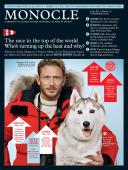
Issue 68
The race to the top of the world — who’s turning up the heat and why? Kiruna to Nuuk, Skagway to Santa’s village (it’s in Finland you know): our editors don their goose-down for a special Arctic Report. Bundle up.
In This Issue
Oops! No content was found.
Looks like we no longer have content for the page you're on. Perhaps try a search?
Return Home

